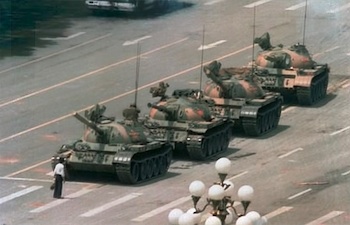It’s been 20 years since the Tiananmen Square massacre. Of the many things I’ve seen commemorating it, one of the most powerful was John Birmingham’s simple blog post of that day’s diplomatic messages from the US Embassy in Beijing.
Cable, From: Department of State, Wash DC, To: US Embassy Beijing, and All Diplomatic and Consular Posts, TFCHO1: SITREP 1, 1700 EDT (June 3, 1989)
PLA MOVES ON TIANANMEN, CASULATIES HIGH. EMBASSY BEIJING REPORTS THAT TROOPS USING AUTOMATIC WEAPONS ADVANCED IN TANKS, APCS AND TRUCKS FROM SEVERAL DIRECTIONS ON TIANANMEN SQUARE JUNE 3. THERE WAS CONSIDERABLE RESISTENCE BY DEMONSTRATORS, AND THE NUMBER OF CASUALTIES APPEARS HIGH.
Please read them all and, as I did, take a moment to reflect.
According to Wikipedia, “There were early reports of Chinese Red Cross sources giving a figure of 2,600 deaths, but the Chinese Red Cross has denied ever doing so. The official Chinese government figure is 241 dead, including soldiers, and 7,000 wounded.”
NATO intelligence puts the death toll at 7,000. Some other estimates are even higher.
China has blocked access to most social media sites such as Twitter, search engines, and many others. Yes. Let’s just stifle conversation and pretend it didn’t happen. Cowards.
I’ll wager this photograph of artist Him Lo, taken in Hong Kong yesterday, won’t be seen across the Middle Kingdom either.
[Photo: Tank Man, taken on 5 June 1989 by photographer Jeff Widener, depicts an unknown man halting the PLA’s advancing tanks near Tiananmen Square.]


There is an excellent documentary on both the Tiananmen Square massacre and the “Tank Man” at PBS that can be watched online (it has also been shown on SBS a couple of times).
FRONTLINE: The Tank Man
Seventeen years later, veteran filmmaker Antony Thomas goes to China in search of “The Tank Man.” Who was he? What was his fate? And what does he mean for a China that today has become a global economic powerhouse?